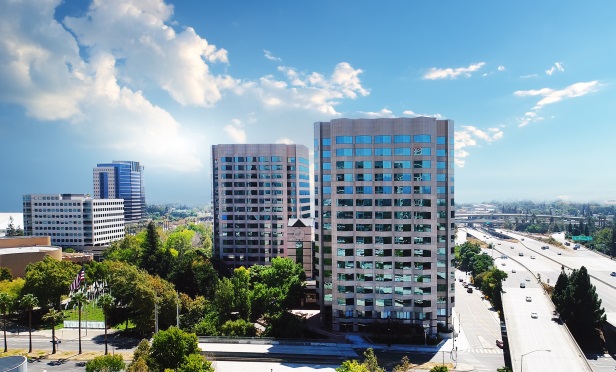 Cohesity's recent downtown lease brings RiverPark Towers' occupancy rate to 97%.
Cohesity's recent downtown lease brings RiverPark Towers' occupancy rate to 97%.
SAN JOSE—RiverPark Towers, a pair of twin buildings along West San Carlos Street and Park Avenue, have played a significant role in the continuing popularity of downtown by attracting new tech companies to the submarket. The towers are in the center of downtown activity near the San Jose Center for the Performing Arts, San Jose Convention Center, SAP Center and most importantly, Diridon Station.
Included in that tech leasing niche, Cohesity will soon occupy three new floors of RiverPark Tower I, in addition to the five floors it already occupies in RiverPark Tower II. The lease is part of a 60,183-square-foot expansion deal with the data storage technology company.
Newmark Knight Frank advised landlords DivcoWest and Rockpoint Group. The NKF broker team on the deal included vice chairman Phil Mahoney, senior managing director Anne Ralston and executive managing directors Mike Saign and Joe Kelly of the firm's San Jose office. NKF's lease-up strategy brings RiverPark Towers' occupancy rate to 97%.
“The tech momentum in downtown San Jose is at an all-time high. Cohesity's latest expansion is yet another example of this trend,” Saign tells GlobeSt.com. “With that said, the evolution of this urban epicenter of Silicon Valley has its brightest days ahead.”
Another point of interest for San Jose is the buzz around Opportunity Zones. With 11 designated Census tracts, San Jose has the most zones in Silicon Valley, and investors have responded by looking for deals throughout the new zones, especially in downtown, according to the city of San Jose.
As a city, San Jose doesn't have a formal implementation role under the Opportunity Zone statute, which was included in the 2017 Tax Cuts and Jobs Act. But it is keenly interested in facilitating investment that helps fulfill the city's general plan, grows housing opportunities, activates transit and increases jobs.
Moreover, as early as 2003, San Jose saw the challenges in categorizing office users, and created new categories that spanned the gap. Because of the way its tax code works, the city has always included sunset provisions in these categories so it can go back and make changes.
The latest of these changes, which used a definition of “office, research and development” to identify tech users as “industrial”, expired in March 2017. City staff brought forward a plan to create a new category that treated all types of office the same, regardless of whether it is tech, finance or some other general business office, and tax those users at a reduced 2% rate.
Rather than implementing the change right away, the city council gave a two-year extension to the previous program to allow projects that had already been planned to move forward. On March 31, that program was discontinued and the new 2% office rate went into effect this month.
© Touchpoint Markets, All Rights Reserved. Request academic re-use from www.copyright.com. All other uses, submit a request to [email protected]. For more inforrmation visit Asset & Logo Licensing.







